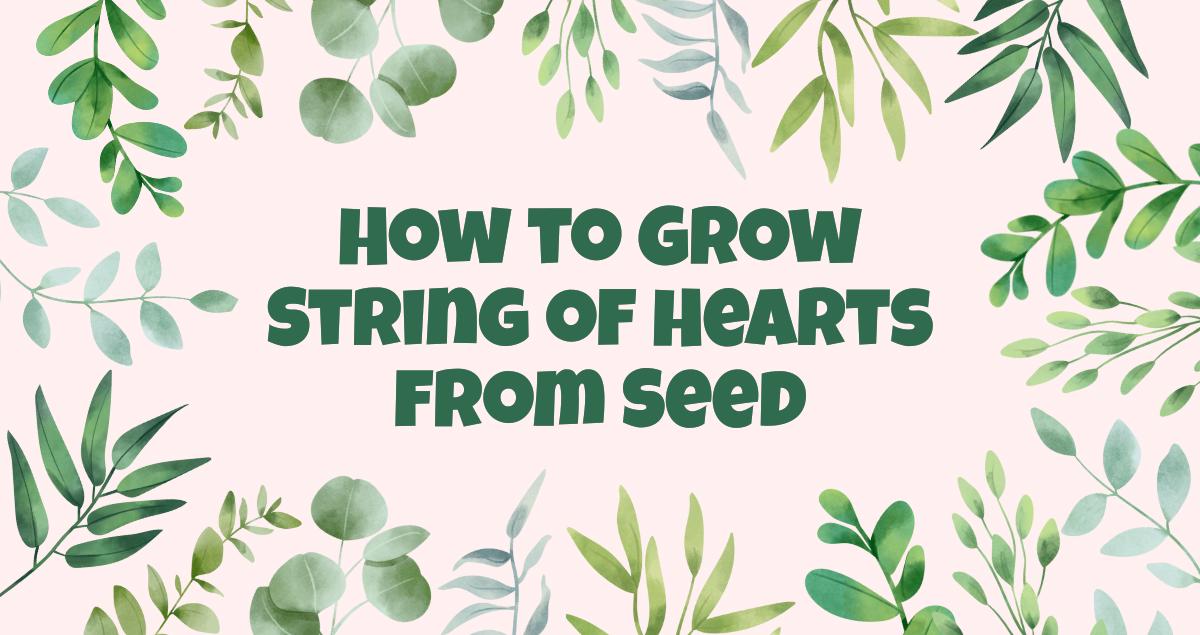The string of hearts plant, also known as Ceropegia woodii, is a popular trailing succulent that is loved for its delicate heart-shaped leaves and cascading vines. While it is commonly propagated through stem cuttings, growing string of hearts from seed can be a rewarding and fulfilling experience. In this article, we will guide you through the process of growing string of hearts from seed, from choosing the right seeds to caring for the seedlings and maintaining mature plants.
Table of Content
How to Grow String of Hearts from Seed
To grow string of hearts from seed, start by soaking the seeds in water for 24 hours. Then, fill a small pot with well-draining soil and plant the seeds about 1/4 inch deep. Keep the soil moist but not soggy and place the pot in a warm, bright location. Germination can take several weeks, but with patience and proper care, you can successfully grow string of hearts from seed.
Choosing the Right Seeds
Understanding String of Hearts
The string of hearts plant is native to South Africa and belongs to the Apocynaceae family. It is a succulent vine that can reach up to 12 feet in length and is characterized by its small, heart-shaped leaves that grow in pairs along the stems. The leaves have a unique silver-green color with patterns of light and dark veins, giving the plant a distinctive appearance.
Types of Seeds
When it comes to growing string of hearts from seed, there are a few options available. You can either collect seeds from a mature string of hearts plant or purchase them from a reputable supplier. It's important to note that string of hearts seeds are not always readily available, so you may need to do some research or reach out to local nurseries or online sellers to find a reliable source.
Preparing the Seeds
Seed Collection
To collect seeds from a mature string of hearts plant, you'll need to wait until the plant produces small, elongated seed pods. These pods will eventually dry out and split open, revealing the seeds inside. Gently remove the seeds from the pods and place them in a clean container.
Seed Cleaning
Before you can germinate the seeds, it's important to clean them to remove any debris or impurities. Start by rinsing the seeds under running water to remove any dirt or dust. Then, fill a small bowl with water and gently agitate the seeds to help separate them from any remaining debris. Once the seeds are clean, transfer them to a paper towel and pat them dry.
Seed Storage
To maintain the viability of your string of hearts seeds, it's crucial to store them properly. Place the cleaned and dried seeds in an airtight container, such as a small glass jar or a resealable plastic bag. Store the container in a cool, dark place, such as a refrigerator, to keep the seeds dormant until you're ready to germinate them.
Germination Process
Seed Stratification
String of hearts seeds require a process called stratification to break their dormancy and stimulate germination. This process involves exposing the seeds to a period of cold temperatures, mimicking the natural conditions they would experience in their native habitat. To stratify the seeds, place them in a damp paper towel and seal them in a plastic bag. Then, refrigerate the bag for 4-6 weeks.
Sowing the Seeds
After the stratification period, it's time to sow the string of hearts seeds. Fill a small seed tray or pots with a well-draining potting mix, such as a mixture of perlite and peat moss. Make small indentations in the soil and place one or two seeds in each indentation. Lightly cover the seeds with a thin layer of soil and mist the surface with water to provide moisture.
Germination Conditions
For successful germination, it's important to provide the ideal environmental conditions. Place the seed tray or pots in a warm location with indirect sunlight. Maintain a temperature of around 70-75°F (21-24°C) and keep the soil consistently moist but not waterlogged. You can cover the tray or pots with a plastic dome or a clear plastic bag to create a greenhouse-like environment and retain moisture.
Caring for Seedlings
Light Requirements
Once the seedlings emerge, they will need bright but indirect light to grow and thrive. Place them in a location with bright, filtered sunlight, such as near a north or east-facing window. Avoid exposing the seedlings to direct sunlight, as it can scorch their delicate leaves.
Watering and Moisture
Proper watering is crucial for the health of the seedlings. Water them when the top inch of soil feels dry, using a watering can or spray bottle to gently moisten the soil. Be careful not to overwater, as excessive moisture can lead to root rot. It's also important to maintain a moderate level of humidity around the seedlings, as they prefer slightly humid conditions.
Temperature and Humidity
String of hearts seedlings thrive in warm temperatures, ideally between 70-75°F (21-24°C). Avoid exposing them to extreme temperature fluctuations or drafts, as it can stress the plants. Additionally, maintaining a moderate level of humidity around the seedlings can help prevent the leaves from drying out and promote healthy growth.
Transplanting Seedlings
Once the seedlings have grown a few sets of leaves and are well-established, they can be safely transplanted into larger containers. Choose a pot with drainage holes and fill it with a well-draining potting mix. Gently remove the seedlings from their original containers and place them in the new pots, ensuring that the roots are covered with soil. Water the newly transplanted seedlings and continue to care for them as they mature.
Maintaining Mature Plants
Light and Sun Exposure
Mature string of hearts plants require bright, indirect light to maintain their health and vibrant foliage. Place them in a location with bright, filtered sunlight, such as near a window with sheer curtains. Avoid exposing the plants to direct sunlight, as it can cause sunburn and damage the leaves.
Watering and Fertilizing
When it comes to watering mature string of hearts plants, it's important to strike a balance. Water them when the top inch of soil feels dry, allowing the soil to dry out slightly between waterings. Avoid overwatering, as it can lead to root rot. Fertilize the plants with a balanced, water-soluble fertilizer diluted to half strength every 4-6 weeks during the growing season to provide them with essential nutrients.
Pruning and Propagation
Pruning is an important part of maintaining mature string of hearts plants and keeping them looking their best. Regularly trim back any leggy or overgrown vines to promote bushier growth and maintain the desired shape. Additionally, string of hearts plants can be easily propagated by stem cuttings. Simply take a healthy cutting, remove the lower leaves, and place it in a well-draining potting mix. Keep the cutting moist and within a few weeks, it should develop roots and start growing.
Conclusion
Growing string of hearts from seed can be a rewarding and enjoyable experience. By choosing the right seeds, properly preparing them, following the germination process, and caring for the seedlings and mature plants, you can successfully grow your own string of hearts. With its unique heart-shaped leaves and cascading vines, this charming succulent will bring beauty and greenery to any space.
Frequently Asked Questions
How do you propagate string of hearts seed pods?
To propagate string of hearts seed pods, start by collecting the seed pods once they have turned brown and dried on the plant. Gently break open the seed pods to release the small, black seeds. Prepare a well-draining potting mix and sow the seeds on the surface, lightly pressing them into the soil. Keep the soil consistently moist and place the pot in a warm and bright location. The seeds will germinate in a few weeks, and you can transplant the seedlings into individual pots once they have grown a few sets of leaves.
What is the seed ball on string of hearts?
The seed ball on string of hearts refers to the round, pod-like structure that forms after the flowers have been pollinated. These seed balls contain the seeds of the plant and will eventually dry out and split open, releasing the seeds. Each seed ball can contain multiple seeds, which can be collected and used for propagation.
Do Chain of Hearts have seed pods?
Yes, Chain of Hearts (string of hearts) plants do produce seed pods. These seed pods develop after the plant has been pollinated and the flowers have faded. The seed pods are small, round structures that turn brown and dry out as they mature. Inside the seed pods, you will find the seeds of the plant, which can be collected and used for propagation.
What is the most successful way to propagate string of hearts?
The most successful way to propagate string of hearts is through stem cuttings. Select a healthy stem and cut it just below a node. Remove the lower leaves, leaving a few at the top. Allow the cutting to dry and callus for a day or two. Then, insert the cutting into a well-draining potting mix, burying the node and leaving the top portion exposed. Keep the soil lightly moist and place the cutting in a warm and bright location. Roots will develop in a few weeks, and you can then transplant the cutting into its own pot.
Can you grow string of hearts from seeds?
Yes, you can grow string of hearts from seeds. Collect the seed pods once they have dried on the plant. Open the seed pods and collect the small, black seeds. Sow the seeds on the surface of a well-draining potting mix, lightly pressing them into the soil. Keep the soil consistently moist and place the pot in a warm and bright location. The seeds will germinate in a few weeks, and you can transplant the seedlings into individual pots once they have grown a few sets of leaves.
How long does it take for string of hearts seeds to germinate?
String of hearts seeds typically take around 2 to 4 weeks to germinate. However, the germination time can vary depending on various factors such as temperature, humidity, and seed quality. Providing a warm and bright environment, along with consistent moisture, will help promote successful germination.
Can I sow string of hearts seeds directly in the garden?
While it is possible to sow string of hearts seeds directly in the garden, it is generally more successful to start them indoors. Starting the seeds indoors allows for better control over the growing conditions, such as temperature and moisture. Once the seedlings have grown a few sets of leaves and are well-established, they can be transplanted into the garden.

